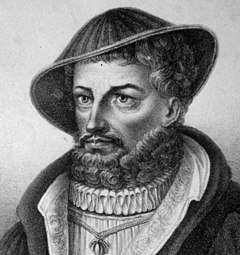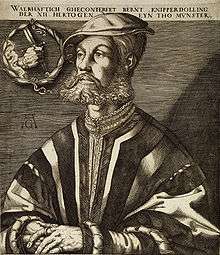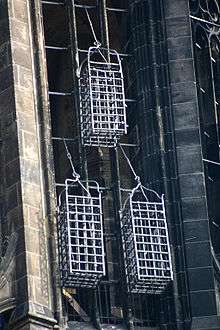John of Leiden
John of Leiden (born Johan Beukelszoon; 2 February 1509 – 22 January 1536) was a Dutch Anabaptist leader who moved to Münster in 1533, capital of the Prince-Bishopric of Münster, where he became an influential prophet, turned the city into a millenarian Anabaptist theocracy, and proclaimed himself King of New Jerusalem in September 1534. The insurrection was suppressed in June 1535 after Prince-Bishop Franz von Waldeck besieged the city and captured John. John was tortured to death in the city's central marketplace on 22 January 1536, along with Bernhard Knipperdolling and Bernhard Krechting.
John of Leiden | |
|---|---|
 | |
| Anabaptist King of Münster | |
| Reign 8 September 1534 – 24 June 1535 | |
| Chancellor | Heinrich Krechting |
| Lieutenant | Bernhard Krechting |
| Stadtholder | Bernhard Knipperdolling |
| Personal details | |
| Born | Johan Beukelszoon 2 February 1509 Zevenhoven, County of Holland, Habsburg Netherlands |
| Died | 22 January 1536 (aged 26) Prinzipalmarkt, Münster, Prince-Bishopric of Münster |
| Spouse(s) | |
| Occupation | Tailor, merchant, innkeeper |
| Known for | Role in the Münster rebellion |
| Influenced by | Jan Matthijsz of Haarlem |
Life

John was the illegitimate son of a Dutch mayor, and a tailor's apprentice by trade. He was born in the village of Zevenhoven in the municipality of Nieuwkoop, located in the Dutch province of South Holland. Raised in poverty, young John became a charismatic leader who was widely revered by his followers. John was an Anabaptist, secretly at first, but later he became a recognized prophet of a sect which would eventually take over the German town of Münster. According to his own testimony, he moved to Münster in 1533 because he had heard there were inspired preachers there. He sent for Jan Matthys, who had baptized him, to come. After his arrival Matthys – recognized as a prophet – became the principal leader of the city. Matthys expelled all of the Catholics from the city shortly after his arrival and set up a communal structure based on the Gospels. He outlawed money and forbade owning property. A Catholic supported army, led by Franz von Waldeck, Prince-Bishop of Münster, Osnabrück and Minden, laid siege to the town of Münster after the Anabaptist takeover. Matthys led an assault on the siege on Easter Sunday 1534, but died quickly. John of Leiden became self-proclaimed "king of the New Jerusalem"[1] until its fall in June 1535.

John of Leiden would lead the Anabaptists during the siege. When he was the leader, he assumed Matthys' position as the prophet and eventually established a Royal Order complete with a Royal Court and a kingly costume, which was made from the property taken from the citizens of Münster. John of Leiden would make many promises to his starving subjects about salvation from the siege and upcoming rewards for their enduring loyalty. This, along with his charisma, kept his position in the city secure until the eventual defeat by the hands of the prince bishop. His motto was: "Gottes macht is myn cracht" (God's might is my strength).

The army of Münster was defeated in 1535 by the prince-bishop Franz von Waldeck, and John of Leiden was captured. He was found in the cellar of a house, from where he was taken to a dungeon in Dülmen, then brought back to Münster. On January 22, 1536, along with Bernhard Krechting and Bernhard Knipperdolling, he was tortured and then executed. Each of the three was attached to a pole by an iron spiked collar and his body ripped with red-hot tongs for the space of an hour. After Knipperdolling saw the process of torturing John of Leiden, he attempted to kill himself with the collar, using it to choke himself. After that the executioner tied him to the stake to make it impossible for him to kill himself. After the burning, their tongues were pulled out with tongs before each was killed with a burning dagger thrust through the heart. The bodies were placed in three iron baskets and hung from the steeple of St. Lambert's Church and the remains left to rot. About fifty years later the bones were removed, but the baskets remain.
Historiography
The conventional view is that John of Leiden set up in Münster a polygamous theocracy, best known for a law John passed stating that any unmarried woman must accept the first proposal of marriage made to her, with the result that men competed to acquire the most wives. Some sources report that John himself took sixteen wives aside from his "Queen" Divara van Haarlem, and that he publicly beheaded one of his wives, Elisabeth Wandscherer, after she rebelled against his authority. Karl Kautsky in his Communism in Central Europe at the Time of the Reformation, notes that this picture of Anabaptist Münster is based almost entirely on accounts written by the Anabaptists' enemies, who sought to justify their bloody reconquest of the city. Kautsky's reading of the sources emphasizes the Anabaptists' emphasis on social equality, political democracy, and communal living during the time of John's nominal rule.
In proverb, on stage and in fiction
- John's name still lives on in the Dutch language, in the saying zich met een Jan(tje) van Leiden van iets afmaken (loosely: To pull a John of Leiden), which means not putting too much effort (or any effort) into something.
- John Leiden features in Thomas Nashe's The Unfortunate Traveller (1594), whose hero, Jack Wilton, satirically describes the siege of Münster and Leiden's death.
- The opera Le prophète (1849) by Giacomo Meyerbeer features John as its hero. It involves the capture of Münster (Acts III and IV), John's coronation as God's elect at the cathedral (Act IV), and its finale is set in John's palace in Münster.
- John appears as a proxy for Hitler in Friedrich Reck-Malleczewen’s 1937 anti-Nazi novel, Bockelson: Geschichte eines Massenwahns ("Bockelson: A Tale of a Mass Insanity").
- John of Leiden is featured in the 1962 Peter Vansittart novel published as The Siege in USA and as Friends of God in the U.K.
- John (as Jan Bockelson) is one of the main protagonists in the 1967 play Die Wiedertäufer by Friedrich Dürrenmatt.
- John of Leiden appears in the novel L'Œuvre au noir or The Abyss by Marguerite Yourcenar, from 1968, in which Yourcenar blends fictitious and real characters, describing the whole Münster Rebellion and its downfall. The passage occupies a short chapter.
- The 1993 German TV drama König der letzten Tage about Leiden features Christoph Waltz as Jan Beuckelszoon and Mario Adorf as Bishop von Waldeck.
- John is also featured in Luther Blissett's novel, Q.
- John (Jan) of Leiden is the central character in Anita Mason's 2003 novel Perfection.
- John is a central character in Jonathon Rainbow's 2010 novel, Speak to Her Kindly,[2] a novel of historical fiction set during the events of the Munster Rebellion.
- The protagonist of Richard Powers's 2014 novel Orfeo composes an opera with John of Leiden as the main character.
References
- Leppäkari, Maria (2006). Apocalyptic Representations of Jerusalem. Leiden: BRILL. p. 105. ISBN 978-90-474-0878-9.
- ISBN 1-57921-590-4
Further reading
- The Tailor-King: The Rise and Fall of the Anabaptist Kingdom of Münster, by Anthony Arthur, ISBN 0-312-26783-5
- The Pursuit of the Millennium by Norman Cohn, ISBN 978-0195004564
External links
| Wikisource has the text of the 1911 Encyclopædia Britannica article Buckholdt, Johann. |
- Dan Carlin's "Hardcore History" #48: Prophets of Doom
- Picture of the cages at St. Lambert's Church
- Polygamy in Münster – by Kate Arms (pdf)
- "Der wedderdoeper eidt" / oath of the Münster Anabaptists
- Online Biography of Jan van Leiden
- Jan Beukelszoon (ca. 1509–1536) in Global Anabaptist Mennonite Encyclopedia Online
- The Siege of Munster from "In Our Time" BBC